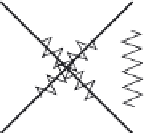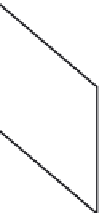Graphics Reference
In-Depth Information
v
1
jjv
1
v
2
j
v
1
v
2
k
s
jv
1
v
2
v
2
F
s
¼
(7.88)
j
j
jv
1
v
2
j
2
jv
1
v
2
j
v
1
v
2
E
s
¼ k
s
1
2
j
v
1
v
2
j
(7.89)
j
j
Restricting the stretching of edges only controls changes to the surface area of the mesh. Skew is in-
plane distortion of the mesh, which still maintains the length of the original edges (
Figure 7.36a,b
)
. To
control such distortion (when using forces), one may employ diagonal springs (
Figure 7.36c
)
. The energy
function suggestedbyDeRose, Kass, andTruong [
29
]
to control skewdistortion is given in
Equation7.90
.
0
@
1
A
0
@
1
A
2
jjv
1
v
2
j
jv
1
v
2
j
1
2
jv
1
v
2
Sðv
1
; v
2
Þ¼
(7.90)
Sðv
1
; v
3
Þ Sðv
2
; v
4
Þ
E
w
¼ k
w
Edge and diagonal springs (energy functions) control in-plane distortions, but out-of-plane distor-
tions are still possible. These include the bending and folding of the mesh along an edge that does not
l
l
l
Skew of original quadrilateral
without changing the length of
edges
A
Original quadrilateral of mesh
B
v
2
v
3
v
4
v
1
C
Diagonal springs to control skew
FIGURE 7.36
Original quadrilateral, skewed quadrilateral, and controlling skew with diagonal springs.

































Search WWH ::

Custom Search